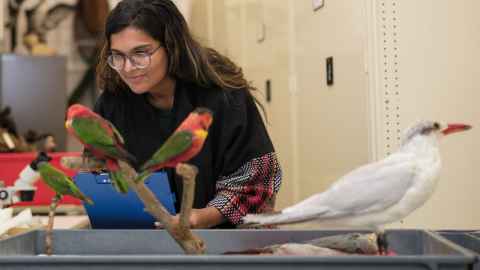Patricia Pillay
Doctoral candidate in the Faculty of Arts and Education

Tell us a bit about yourself
I was born in Pune, just outside the vibrant and bustling city of Mumbai in India. In 1998, my parents migrated to Aotearoa New Zealand where I’ve lived ever since. My heritage is a blend of deep South Indian roots from my dad’s side, and Persian ancestry through my mum, who is Parsi – descended from Zoroastrians who migrated from Persia to India generations ago.
My hobbies are writing food poetry, reading cosy fantasy books, wildlife photography, playing board games with friends and family.
What's next on your travel bucket list?
The Marquesas Islands! Having been fortunate enough to visit some of the majestic Polynesian islands, I would like to visit Te Henua Enata to connect with fenua (land) because of its striking biodiversity, amazing culture, and rich archaeological history including so many striking bird species that I am privileged to be studying.
What are you most passionate about?
I’m passionate about bridging archaeology with biodiversity conservation and heritage management. I believe archaeology offers essential deep-time insight when combined with cultural knowledge. It helps reconnect us with the past and make more informed decisions about the environments we share with other species, now and into the future.
Growing up with a deep curiosity for the natural world, I’ve always been drawn to the silent stories held in bones, landscapes, and cultural memory. That passion drives my work today.
What is the title of your thesis?
Profiling the Past: Investigating human-bird interactions in the Marquesas Islands.
How did you end up in your field of study?
I’ve always been fascinated by wildlife and the rich histories of cultures around the world. As a child, you could usually find me exploring nature, or buried in library books that transported me to incredible places around the world, and even darting through museum galleries, peppering the staff with questions.
When I began university, I discovered archaeology could bring all of my interests together and thanks to some inspiring Anthropology lecturers and tutors during my undergraduate studies, I knew I’d found my place.
What do you hope will change in your field as a result of your research?
I hope my research contributes to a deeper understanding of Marquesan birdlife, especially species that hold cultural significance for local ’Enata (Marquesan) communities, and supports efforts to protect biodiversity in this UNESCO-recognised region.
By building a record of ancient bird histories through archaeological bones, museum collections, and ancient DNA, I aim to show how interdisciplinary research can inform conservation from both scientific and cultural perspectives. No single method is enough.
We need to draw on multiple ways of knowing to face biodiversity loss – especially in regions where critically endangered species remain underrepresented in global data.
What do you plan to do once you have finished your doctorate?
I hope to make my research accessible in creative and inclusive ways, and continue working in the Pacific – an extraordinary region that has shared so much knowledge with me. I’d love to use science communication to give back to communities, helping connect biodiversity research with cultural heritage and local priorities.
Wherever this journey leads, I hope to continue learning, connecting to cultural knowledge, to science, and to the birds who still have stories to tell.
If you could invite four people to dinner, who would they be, and why?
Trevor Noah would be at the top of the guest list – his wit, eloquence, and sharp cultural insight would make him a brilliant dinner companion and conversation catalyst.
Mary Shelley, the mind behind Frankenstein, would fascinate me – not just for her literary brilliance but to explore her thoughts on the modern evolution of science fiction and the ethics of creation.
Michelle Obama would bring extraordinary warmth and vision; I’d love to discuss environmental justice, global education, and how biodiversity fits into a more equitable future.
Finally, Dame Anne Salmond, whose work as an anthropologist in Aotearoa is dedicated to engaging with te ao Māori, Te Tiriti o Waitangi, and human-environmental relationships. Anne is someone I deeply admire for bridging worlds.